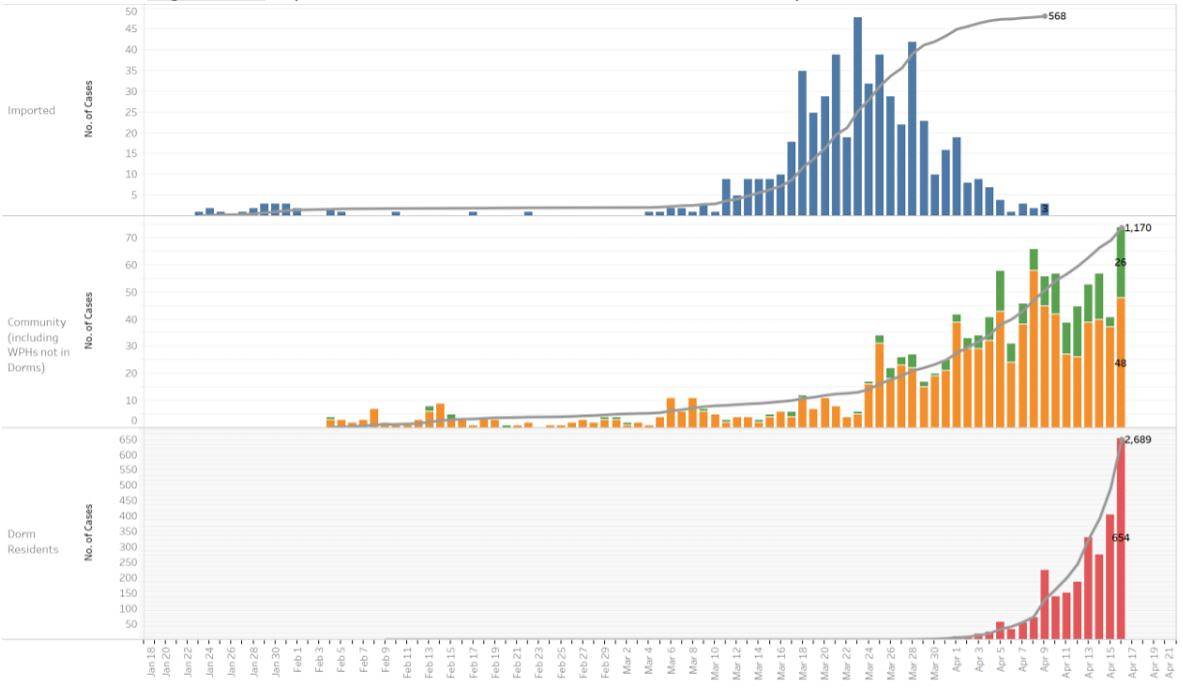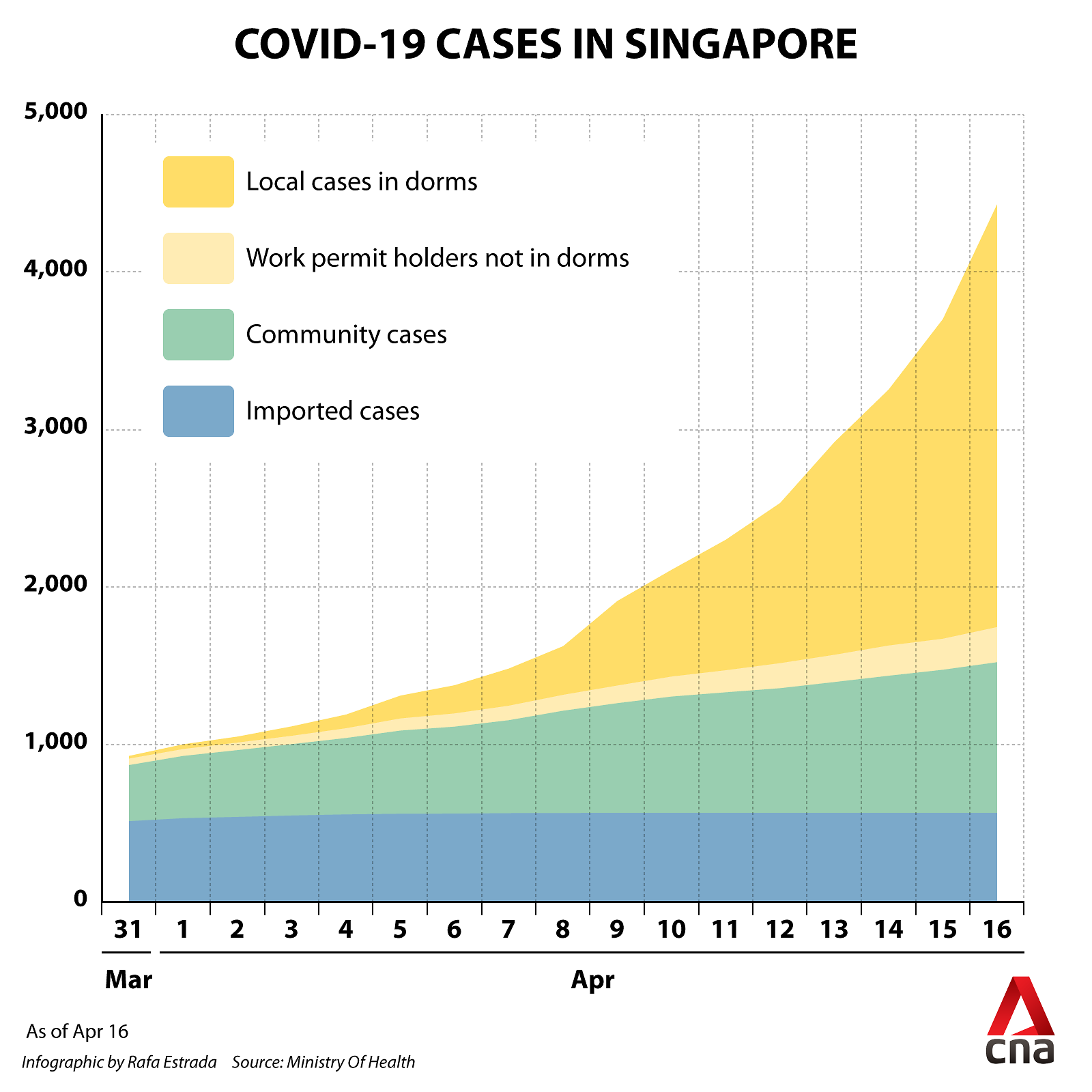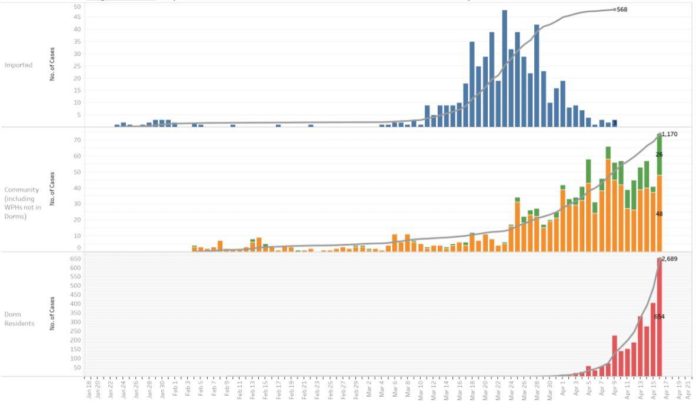SINGAPORE: What was a marginal contributor to Singapore’s COVID-19 situation has quickly become the source of the majority of infections: Of the 4,427 cases here, more than 2,600 can be traced to migrant worker dormitories.
A record 728 new cases were reported on Thursday (Apr 16), with 654 of those infected living at worker dormitories. The number of dormitories with infections has grown to more than 25.
The Health Ministry’s charts show that the cases among work permit holders and dormitory residents began climbing from Apr 1 even as the number infected in the community flattened and imported cases fell to zero – there have been no imported cases in Singapore for a week.

(Source: Ministry of Health)
Before Apr 3, there were just 38 cases in worker dormitories. The number is now 2,689 – a 70-fold increase – and among work permit holders not living at dorms, 218 have been infected, according to the Ministry of Health’s situation report on Thursday.

READ: Singapore reports record 728 new COVID-19 cases, mostly from foreign worker dormitories
INTERACTIVE: All the COVID-19 clusters at dorms and construction sites
Reports of infections among migrant workers trickled in from Mar 30, when 35 new cases of COVID-19 were detected in 24 hours. That day, the S11 Dormitory @ Punggol was named a new cluster with four cases.
Another new cluster at Westlite Toh Guan dormitory was announced the next day, and a third one at a dormitory at 55 Sungei Kadut Loop on Apr 1 – the day the total number of cases in Singapore hit 1,000.
Workers look out of their dorm at Westlite Toh Guan dormitory on Apr 6, 2020. (Photo: Reuters / Edgar Su)
It took only 10 days for that figure to double to 2,000, and three days for it to top 3,000 as the number infected at the dormitories shot up.
DORMITORY LOCKDOWN
Since Jan 23, when the first case of coronavirus was reported here, the Ministry of Manpower (MOM) has advised dormitory operators to put in place preventive measures against COVID-19.
Manpower Minister Josephine Teo recounted some of these measures on Tuesday, saying that they had reached out to dormitory operators to be more vigilant.
“Materials were produced in the workers’ native languages to encourage them to also take steps to protect themselves,” she said.
“Subsequently, non-essential facilities like gyms and TV-rooms were closed. Mealtimes and recreational hours were staggered. Intermixing between blocks was stopped.”
READ: Dormitory operators required to adopt additional measures to minimise risk of COVID-19 transmission: MOM
Still, NGO Transient Workers Count Too warned of the risk among the group in a forum letter to the Straits Times on Mar 23, citing the lack of safe distancing and company policies that penalise workers for failing to show up at work.
After three more clusters were found at dormitories on Apr 4 and cases mounted in earlier clusters, stricter measures kicked in.
S11 @ Punggol and Westlite Toh Guan were declared isolation areas on Apr 5, putting nearly 20,000 migrant workers in quarantine.
READ: COVID-19: Nearly 20,000 foreign workers in quarantine in S11 Dormitory, Westlite Toh Guan
MOM also said that its officers were working “round-the-clock” with the dormitory operators to “prioritise the well-being of workers” as reports of unsanitary conditions and crowding at the locked down dormitories emerged.
A dedicated task force was formed on Apr 7 and the military and police force were roped in to help the MOM and the dorm operators take care of the workers – most of whom have to stay at the dormitories 24/7.
When asked why action was not taken earlier, Mrs Teo said on Apr 9 that it was not a “trivial decision” to implement such measures, before there was evidence that they were necessary.
READ: Inter-agency task force to help migrant workers living in dorms affected by COVID-19
The surge in cases continued unabated as Singapore switched into “circuit breaker” mode last Tuesday.
Why was there this sudden flood of cases? While there have been cases among foreign workers before, this time, the speed and extent of transmission was on a different scale.
As they worked, mostly at construction sites, or gathered outside for social activities, the virus had spread among them; they then brought it back to the dormitories – where some live 10 or 12 to a room and share toilets, kitchens and communal spaces.
READ: COVID-19: Battling fear and boredom, migrant workers grapple with isolation in dormitories
READ: Conditions at 2 more dormitories under isolation ‘stabilised’: MOM
“Workers from different dormitories on their rest days may also gather. They may socialise and shop at popular places like Mustafa (Centre),” Mrs Teo said on Tuesday.
Back in the dormitories, these workers may cook, relax or eat with another group of friends, she said.
“Despite the safe distancing measures, the virus in the dorms spread through social activities much like it would spread among housemates, friends and in the community,” she added.
This may explain why large numbers of workers who tested positive for COVID-19, many from Bangladesh or India, emerged at some dormitories after March, said Mrs Teo.
MUSTAFA CENTRE IN THE SPOTLIGHT
A cluster at Mustafa Centre is believed to have played a part in this explosion of cases, with the spread of the coronavirus likely accelerated by the tight living quarters of the workers.
Last week, MOH’s director of medical services Kenneth Mak told reporters that preliminary investigations found the clusters at Project Glory construction site and five dormitories were linked to the Mustafa Centre cluster.
Other clusters at constructions sites have been linked to the dorm clusters. They include a renovation site at the National University Hospital, construction sites and industrial buildings.
Many of the workers had very mild symptoms and continued to work, leading to delays in testing them, National Development Minister Lawrence Wong said on Apr 9.
“So it’s very likely that the virus spread has been going around for some time in the dormitories, and we are now seeing all the indicators of it,” he said then.
That day, as Singapore reported 202 new COVID-19 cases at dormitory clusters, Mr Wong said that a dedicated strategy for the outbreak at the worker dormitories was needed.
READ: ‘Dedicated strategy’ to break COVID-19 spread in dormitories, including housing healthy workers in army camps
Safe distancing measures have been implemented at the dorms and thousands of workers are being screened and then moved out of dormitories to places such as vacant flats, floating hotels and military camps.
The rapidly evolving situation meant that authorities have also rolled out measures in quick succession to control the outbreak.
As the migrant workers marked the Tamil and Bengali new year on Tuesday, Mrs Teo elaborated on the action taken to contain the spread of the virus at dormitories.
The dormitories with COVID-19 clusters are “locking down” to minimise interaction among the workers, who are being tested to isolate those who are infected. Medical teams comprising doctors and nurses from hospitals and polyclinics are also being deployed to the dorms.
At other dormitories, the aim is to prevent clusters from forming by enforcing strict safe distancing.
Essential workers have been moved out so that they do not have to enter and leave the dormitories daily, or interact with the dormitory residents. With more space at the dormitories, workers who are unwell or are waiting for the results of their swab tests can then be housed separately.
READ: Top India personalities send COVID-19 messages to Singapore’s foreign workers
COVID-19: Bangladeshi worker, whose wife gave birth while he was in critical state, moves out of ICU
More infections at more dormitories were detected over the next few days. As of Thursday, S11 Dormitory is the largest cluster in Singapore with 979 cases.
More than 25 dormitories are now affected all over the island, and most are purpose-built ones, of which there are 43 housing about 200,000 workers. Most factory-converted dormitories have not been affected, Mrs Teo had said.
Ten more dormitories have been isolated: Toh Guan Dormitory, Sungei Tengah Lodge, Tampines Dormitory, Cochrane Lodge I, Cochrane Lodge II, Tuas View Dormitory, Mandai Lodge, North Coast Lodge, Shaw Lodge and Acacia Lodge.
Testing has been stepped up, said Assoc Prof Mak on Tuesday, and high-risk workers who are asymptomatic, such as those sharing a room with confirmed cases, are also being tested.
This extensive testing has also contributed to the rise in numbers and Assoc Prof Mak said then that this does not necessarily imply community transmission.
It also means that the number of cases from dormitories, and in Singapore as a whole, will likely continue to rise in the coming days before stabilising.
BOOKMARK THIS: Our comprehensive coverage of the coronavirus outbreak and its developments
Download our app or subscribe to our Telegram channel for the latest updates on the coronavirus outbreak: https://cna.asia/telegram





